#b. 1968 french illustrator
Explore tagged Tumblr posts
Text

Gérard DuBois
16 notes
·
View notes
Text

Illustration by Benoît Prévot (b. 1968), French artist.
41 notes
·
View notes
Text
Birthdays 8.14
Beer Birthdays
Eugene L. Husting (1848)
Brandon Hernández (1976)
Five Favorite Birthdays
Halle Berry; actor (1968)
Mila Kunis; Ukrainian-American actor (1983)
Gary Larson; cartoonist (1950)
Steve Martin; comedian, actor, writer, banjo player (1945)
Bruce Thomas; English bass player (1948)
Famous Birthdays
Russell Baker; essayist (1925)
Emmanuelle Béart; French actress (1963)
Catherine Bell; actor (1968)
Herman Branson; African-American physicist, chemist (1914)
Sarah Brightman; English singer-songwriter (1960)
John Brodie; San Francisco 49ers QB (1935)
Lodewijk Bruckman; Dutch painter (1903)
Sharon Bryant; R&B singer (1956)
Kevin Cadogan; rock singer-songwriter, guitarist (1970)
Méric Casaubon; Swiss-English author (1599)
Yannoulis Chalepas; Greek sculptor (1851)
Darrell "Dash" Crofts; singer-songwriter and musician (1940)
David Crosby; rock singer (1941)
Charles Jean de la Vallée-Poussin; Belgian mathematician (1866)
Mstislav Dobuzhinsky; Russian-Lithuanian-American artist (1875)
Slim Dunlap; singer-songwriter and guitarist (1951)
Tracy Caldwell Dyson; chemist and astronaut (!969)
Richard R. Ernst; Swiss chemist (1933)
Erica Flapan; mathematician (1956)
Francis Ford; actor and director (1881)
John Galsworthy; English writer (1867)
Alice Ghostley; actor (1926)
Larry Graham; soul/funk bass player and singer-songwriter (1946)
Buddy Greco; singer, pianist (1926)
Marcia Gay Harden; actor (1959)
Jackée Harry; actress (1956)
Robert Hayman; English-Canadian poet (1575)
Lee Hoffman; author (1932)
Leopold Hofmann; Austrian composer (1738)
Doc Holliday; dentist, wild west gambler (1851)
James Horner; composer (1953)
Ernest Everett Just; African-American biologist (1883)
Jan Koetsier; Dutch composer (1911)
Margaret Lindsay Huggins; Anglo-Irish astronomer (1848)
William Hutchinson; founder of Rhode Island (1586)
Magic Johnson; Los Angeles Lakers (1959)
Stanley A. McChrystal; American general (1954)
John McCutcheon; folksinger (1952)
Paddy McGuinness; English comedian (1973)
Lionel Morton; English singer-songwriter, guitarist (1942)
Bruce Nash; film director (1947)
Frank Oppenheimer; particle physicist (1912)
Hans Christian Ørsted; Danish physicist and chemist (1777)
Susan Saint James; actor (1946)
Paolo Sarpi; Italian writer (1552)
Ben Sidran; jazz and rock keyboardist (1943)
Stuff Smith; violinist (1909)
Danielle Steel; writer (1947)
Jiro Taniguchi; Japanese author and illustrator (1947)
Bruno Tesch; German chemist (1890)
Ernest Thayer; "Casey at the Bat" writer (1863)
Pieter Coecke van Aelst; Flemish painter (1502)
Carle Vernet; French painter and lithographer (1758)
Claude Joseph Vernet; French painter (1714)
Earl Weaver; Baltimore Orioles manager (1930)
Wim Wenders; German film director (1945)
Lina Wertmüller; Italian film director (1926)
2 notes
·
View notes
Text
On this day in Wikipedia: Wednesday, 3rd January
Welcome, ongi etorri, hoş geldiniz, benvenuto 🤗 What does @Wikipedia say about 3rd January through the years 🏛️📜🗓️?

3rd January 2023 🗓️ : Event - Jurong Bird Park Singapore's Jurong Bird Park permanently closes. "Jurong Bird Park was formerly an aviary and tourist attraction in Jurong, Singapore between 1971 and 2023. The largest such bird park in Asia, it covers an area of 0.2 square kilometres (49 acres) on the western slope of Jurong Hill, the highest point in the Jurong region. It was one of the parks..."

Image licensed under CC BY 2.0? by aamanatullah
3rd January 2019 🗓️ : Event - Chang'e 4 Chang'e 4 makes the first soft landing on the far side of the Moon, deploying the Yutu-2 lunar rover. "Chang'e 4 (; Chinese: 嫦娥四号; pinyin: Cháng'é Sìhào; lit. 'Chang'e No. 4') is a robotic spacecraft mission in the Chinese Lunar Exploration Program of the CNSA. China achieved humanity's first soft landing on the far side of the Moon with its touchdown on 3 January 2019.A communication relay..."
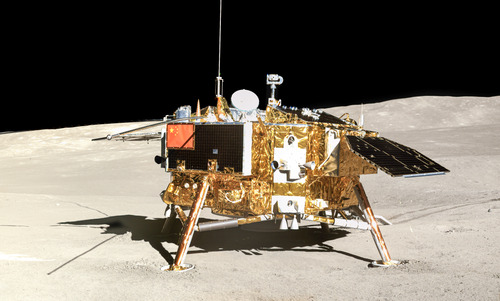
Image licensed under CC BY 2.0? by CSNA/Siyu Zhang/Kevin M. Gill
3rd January 2014 🗓️ : Death - Phil Everly Phil Everly, American singer and guitarist (b. 1939) "Phillip Everly (January 19, 1939 – January 3, 2014) was an American musician, who was one half of the duo The Everly Brothers alongside his older brother Don. ..."

Image by Bruno of Hollywood
3rd January 1974 🗓️ : Birth - Todd Warriner Todd Warriner, Canadian ice hockey player "Todd Eaton Warriner (born January 3, 1974) is a Canadian former professional ice hockey forward. Over the course of his career, Warriner played for the Toronto Maple Leafs, Tampa Bay Lightning, Phoenix Coyotes, Vancouver Canucks, Philadelphia Flyers, and Nashville Predators of the NHL. He also..."
3rd January 1924 🗓️ : Birth - André Franquin André Franquin, Belgian author and illustrator (d. 1997) "André Franquin (French: [fʁɑ̃kɛ̃]; 3 January 1924 – 5 January 1997) was an influential Belgian comics artist, whose best-known creations are Gaston and Marsupilami. He also produced the Spirou et Fantasio comic strip from 1946 to 1968, a period seen by many as the series' golden age...."
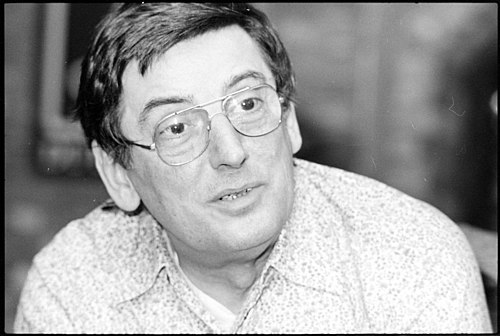
Image licensed under CC0? by Fotopersbureau De Boer
3rd January 1819 🗓️ : Birth - Charles Piazzi Smyth Charles Piazzi Smyth, Italian-Scottish astronomer and academic (d. 1900) "Charles Piazzi Smyth (3 January 1819 – 21 February 1900) was an Italian-born British astronomer who was Astronomer Royal for Scotland from 1846 to 1888; he is known for many innovations in astronomy and, along with his wife Jessica Duncan Piazzi Smyth, his pyramidological and metrological studies..."

Image by John Faed
3rd January 🗓️ : Holiday - Christian feast day: Kuriakose Elias Chavara (Syro-Malabar Catholic Church) "Kuriakose Elias Chavara, CMI (10 February 1805 – 3 January 1871) was an Indian Syro-Malabar Catholic priest, religious, philosopher and social reformer. He is the first canonised Catholic male saint of Indian origin and a member of the Syro-Malabar Church, an Eastern Catholic church. He was the..."
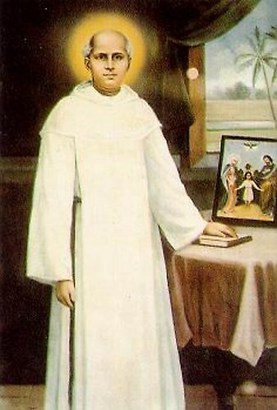
Image by zeitgenössischer Künstler
0 notes
Text
Deaths On This Day – December - 22
Pre-1600
AD 69 – Vitellius, Roman emperor (b. 15)
731 – Yuan Qianyao, official of the Chinese Tang Dynasty
1012 – Baha' al-Dawla, Buyid amir of Iraq
1060 – Cynesige, Archbishop of York
1100 – Bretislav II of Bohemia (b. 1060)
1115 – Olaf Magnusson, King of Norway (b. 1099)
1419 – Antipope John XXIII
1530 – Willibald Pirckheimer, German lawyer and author (b. 1470)
1554 – Alessandro Bonvicino, Italian painter (b. 1498)
1572 – François Clouet, French miniaturist (b. c. 1510)
1601–1900
1603 – Mehmed III, Ottoman sultan (b. 1566)
1641 – Maximilien de Béthune, Duke of Sully, 2nd Prime Minister of France (b. 1560)
1646 – Petro Mohyla, Ruthenian metropolitan and saint (b. 1596)
1660 – André Tacquet, Flemish priest and mathematician (b. 1612)
1666 – Guercino, Italian painter (b. 1591)
1681 – Richard Alleine, English minister and author (b. 1611)
1767 – John Newbery, English publisher (b. 1713)
1788 – Percivall Pott, English physician and surgeon (b. 1714)
1806 – William Vernon, English-American merchant (b. 1719)
1828 – William Hyde Wollaston, English chemist and physicist (b. 1766)
1853 – Manuel María Lombardini, Mexican general and politician. President (1853) (b. 1802)
1867 – Jean-Victor Poncelet, French mathematician and engineer (b. 1788)
1870 – Gustavo Adolfo Bécquer, Spanish journalist, poet, and playwright (b. 1836)
1880 – George Eliot, English novelist and poet (b. 1819)
1891 – Paul de Lagarde, German biblical scholar and orientalist (b. 1827)
1899 – Dwight L. Moody, American evangelist and publisher, founded Moody Publishers (b. 1837)
1901–present
1902 – Richard von Krafft-Ebing, German-Austrian psychiatrist and author (b. 1840)
1915 – Rose Talbot Bullard, American medical doctor and professor (b. 1864)
1917 – Frances Xavier Cabrini, Italian-American nun and saint (b. 1850)
1918 – Aristeidis Moraitinis, Greek lieutenant and pilot (b. 1891)
1919 – Hermann Weingärtner, German gymnast (b. 1864)
1925 – Amelie Beese, German pilot and engineer (b. 1886)
1939 – Ma Rainey, American singer (b. 1886)
1940 – Nathanael West, American author and screenwriter (b. 1903)
1941 – Karel Hašler, Czech actor, director, composer, and screenwriter (b. 1879)
1942 – Franz Boas, German-American anthropologist and linguist (b. 1858)
1943 – Beatrix Potter, English children's book writer and illustrator (b. 1866)
1944 – Harry Langdon, American actor, comedian, and vaudevillian (b. 1884)
1950 – Frederick Freake, English polo player (b. 1876)
1957 – Frank George Woollard, English engineer (b. 1883)
1959 – Gilda Gray, Polish-American actress and dancer (b. 1901)
1960 – Ninian Comper, Scottish-English architect (b. 1864)
1962 – Ross McLarty, Australian politician, 17th Premier of Western Australia (b. 1891)
1965 – Richard Dimbleby, English journalist (b. 1913)
1968 – Raymond Gram Swing, American journalist (b. 1887)
1969 – Enrique Peñaranda, 45th President of Bolivia (b. 1892)
1971 – Godfried Bomans, Dutch journalist and author (b. 1913)
1974 – Sterling North, American author and critic (b. 1906)
1979 – Darryl F. Zanuck, American director and producer (b. 1902)
1985 – D. Boon, American singer and musician (b. 1958)
1986 – Mary Burchell, English author and activist (b. 1904)
1986 – David Penhaligon, Cornish Liberal Politician (b. 1944), Member of Parliament (MP) for Truro (1974-1986)
1987 – Luca Prodan, Italian-Scottish singer-songwriter and guitarist (b. 1953)
1988 – Chico Mendes, Brazilian trade union leader and activist (b. 1944)
1989 – Samuel Beckett, Irish author, poet, and playwright, Nobel Prize laureate (b. 1906)
1992 – Harry Bluestone, English violinist and composer (b. 1907)
1992 – Frederick William Franz, American religious leader (b. 1893)
1993 – Don DeFore, American actor (b. 1913)
1995 – Butterfly McQueen, American actress and dancer (b. 1911)
1995 – James Meade, English economist and academic, Nobel Prize laureate (b. 1907)
1996 – Jack Hamm, American cartoonist and television host (b. 1916)
1997 – Sebastian Arcos Bergnes, Cuban-American dentist and activist (b. 1931)
2001 – Ovidiu Iacov, Romanian footballer (b. 1981)
2001 – Walter Newton Read, American lawyer and second chairman of the New Jersey Casino Control Commission (b. 1918)
2002 – Desmond Hoyte, Guyanese lawyer, politician and President of Guyana (b. 1929)
2002 – Joe Strummer, English singer-songwriter (b. 1952)
2004 – Doug Ault, American baseball player and manager (b. 1950)
2006 – Elena Mukhina, Russian gymnast (b. 1960)
2006 – Galina Ustvolskaya, Russian composer (b. 1919)
2007 – Charles Court, Australian politician, 21st Premier of Western Australia (b. 1911)
2007 – Adrian Cristobal, Filipino journalist and playwright (b. 1932)
2009 – Luis Francisco Cuéllar, Colombian rancher and politician (b. 1940)
2009 – Albert Scanlon, English footballer (b. 1935)
2010 – Fred Foy, American soldier and announcer (b. 1921)
2012 – Chuck Cherundolo, American football player and coach (b. 1916)
2012 – Ryan Freel, American baseball player (b. 1976)
2012 – Cliff Osmond, American actor, director, producer, and screenwriter (b. 1937)
2012 – Lim Keng Yaik, Malaysian physician and politician (b. 1939)
2013 – Diomedes Díaz, Colombian singer-songwriter (b. 1956)
2013 – Hans Hækkerup, Danish lawyer and politician (b. 1945)
2013 – Oscar Peer, Swiss author, playwright, and philologist (b. 1928)
2014 – John Robert Beyster, American physicist and academic (b. 1924)
2014 – Christine Cavanaugh, American actress (b. 1963)
2014 – Joe Cocker, English singer-songwriter (b. 1944)
2014 – Bernard Stone, American lawyer and politician (b. 1927)
2015 – Peter Lundblad, Swedish singer-songwriter (b. 1950)
2015 – Freda Meissner-Blau, Australian activist and politician (b. 1927)
2016 – Chad Robinson, Australian rugby league player (b. 1980)
2017 – Gonzalo Morales Sáurez, Costa Rican painter (b. 1945)
2018 – Simcha Rotem, last survivor of the Warsaw Ghetto Uprising (b. 1924)
2018 – Herman Sikumbang, Indonesian guitarist (b. 1982); casualty during 2018 Sunda Strait tsunami
2019 – Ram Dass, American spiritual teacher and author (b. 1931)
0 notes
Text
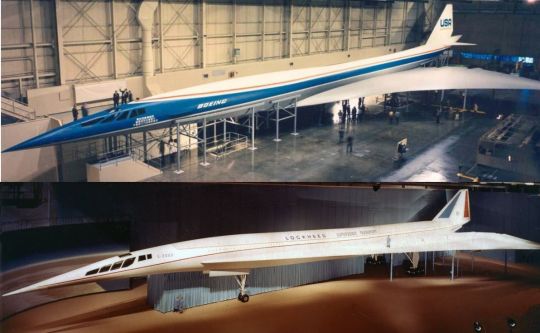
-Mockups of the two final American SST concepts, the Boeing 2707 and the Lockheed L-2000. | Composite Photo: Justin Gibb
FLIGHTLINE: 136 - AMERICAN SST PROGRAM
Various programs to develop a supersonic transport in the US stretched from the middle 1950s until the early 1970s, but no aircraft ever resulted.
The first recorded supersonic flight (the speed of sound is 767mph at 20°C/68°F at sea level) was on 14 October 1947, when the American X-1, piloted by Chuck Yeager, reached Mach 1.06. By the 1950s, supersonic flight became a more regular occurrence, though it was still almost exclusively restricted to military pilots. Around this time, various projects around the world began to develop airliners that could break the sound barrier too. Designs like the Sud Aviation Super-Caravelle and Bristol Type 223 were sketched, but technical limitations as well as a lack of funding stalled those efforts.
♫NINETY MINUTES FROM NEW YORK TO PARIS♫
Research continued however, and by the early-1960s a new round of programs were started, with BAC (later BAe and BAE Systems) and Sud Aviation (later Aérospatiale and Airbus) joining forces to produce what became Concorde, while the Soviet design bureau Tupolev developed the Tu-144 (NATO reporting name "Charger"). Numerous American carriers placed orders for Concorde aircraft, but spiraling costs and a desire to develop a domestic SST saw those orders canceled in the early 1970s. In the end, only Air France and BOAC/British Airways operated Concorde, while the Tu-144 was exclusively flown by the Soviet state airline Aeroflot.
BUY AMERICAN!
The FAA estimated in the early 1960s that there would be a market for 500+ SSTs by the year 1990. Fearing Anglo-French domination of the airline industry, the US Congress began funding various research programs, and President John F Kennedy announced a National Supersonic Transport program on 5 June 1963. Requests for proposals were sent to Boeing, Lockheed, and North American for the airframes; and Curtiss-Wright, General Electric and Pratt & Whitney for engines. The request stipulated a cruise speed of Mach 3, and a passenger capacity of up to 300. Preliminary designs were submitted on 15 January 1964
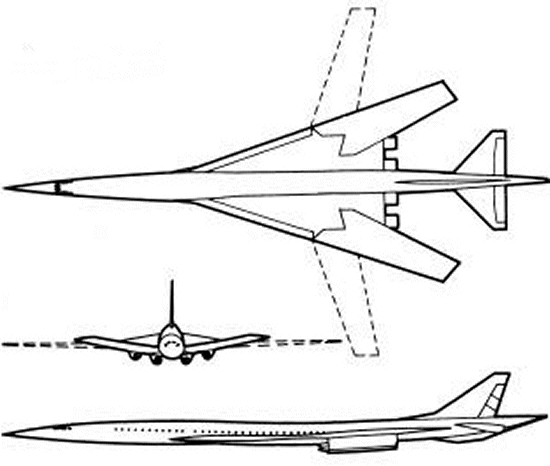
-Line drawing of the Boeing 733-790 SST, which initially featured swing wings. | Illustration: Boeing
The Boeing 733 model featured a large blended wing root with variable geometry outer panels, resembling an enlarged Rockwell B-1. The proposal included optional fuselage extensions, potentially increasing capacity to 227 passengers.

-Line drawing of the the CL-823. | Illustration: Lockheed Corp.
Lockheed's CL-823 was functionally an enlarged Concorde, though the wing shape was a cranked arrow rather than Concorde's ogival delta.
The North American NAC-60 was the smallest and slowest of the competitors, potentially transporting 187 passengers at Mach 2.65.
In 1965 the FAA downselected the NAC-60 design, as well as Curtiss-Wright's engine work, freeing up funds for Boeing and Lockheed on the airframe side and P&W and GE for the engine development.
TIME TO SHARPEN YOUR PENCIL.
The FAA scheduled a final selection in 1966, and requested detailed proposals from Boeing and Lockheed. Boeing had gone through several iterations of the Model 733, with the 733-390 being presented in September 1966. The aircraft was one of the first wide-body airliners, with 2-3-2 seating. In the 30-seat first class section, small tv's were to be integrated into a console between the seats, while in the 247-seat tourist class section larger retractable tv's would drop from the overheads every six rows. Externally, the engine pods had been moved back under the tail, and the wings, when swept back, would form a delta with the tail.
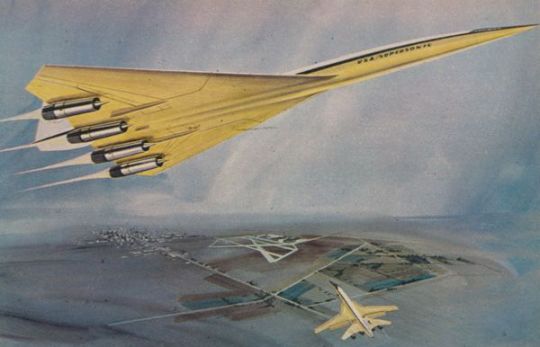
-Illustration of the 733-390, with one at maximum sweep and one at minimum. | Illustration: Boeing.
Lockheed's CL-823 had evolved as well, with the L-2000-1 design having changed from a cranked arrow to a delta wing, with the engines separated into individual pods. In order to speed production, the L-2000 was projected to use a derivative of the J58 engine that had powered the A-12 OXCART and SR-71 Blackbird. New requirements from the government saw changes to the wing and fuselage, and the engine pods were redesigned to accommodate either the P&W JTF-17A or GE4 designed as part of the SST program. The final design presented to the FAA was the L-2000-7A/B (the B was 20 feet longer), which had a passenger capacity of 230.

-Advertising image of the L-2000-7A. | Illustration: Monsigneurhulot
THE FINAL SHOWDOWN
The final designs, complete with full-scale mockups, were presented in September 1966.

-The full-scale mockup of the 733-390, in a striking white-over-yellow paint scheme. The size of the plane is evident from the man standing near the third jack. | Photo: Boeing
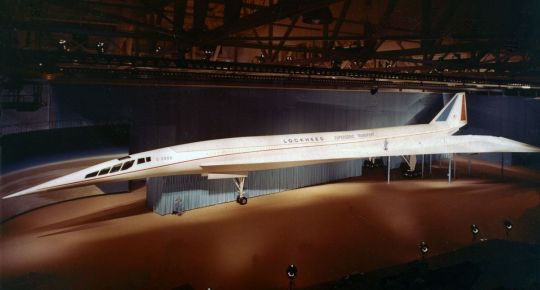
-Appearing no less impressive, the Lockheed L-2000 mockup. | Photo: Lockheed
FAA review of the competing SSTs took until December, with the Boeing design being announced the winner on 1 January 1967. The L-2000 was judged to easier to produce, but it was also thought to be less risky and advanced than the Boeing entry, and thus the latter was more in the spirit of the design mandate. Also, the Lockheed craft was anticipated to be louder with the JTF-17A engines, as well as being slower.
Boeing anticipated construction of the 733-390 prototypes, now referred to as the 2707-200, would begin in 1967, with first flight in 1970. Construction of the production models was expected to commence 1969, with first flight in 1972 and FAA certification anticipated by 1974.

-The public enthusiasm for the SST program was initially high, with scale models and toys of the design being release by multiple companies. Seattle's NBA team, formed in 1967, was initially named the SuperSonics. | Photo: oldmodelkits.com
NO PLAN SURVIVES FIRST CONTACT WITH THE ENEMY (IN THIS CASE, PHYSICS)
Almost immediately, Boeing began encountering problems with the design. Canards were added to improve flight characteristics, but this added weight. The swing wing mechanism were also much heavier than anticipated, with one pivot section being an eleven feet long, two-and-a-half feet thick piece of titanium weighing 4,600lbs. All of this added weight was eating into the plane's range and lowering the speed, and in October 1968 the company made the decision to delete the variable geometry wings and utilize a fixed delta instead. Fabrication of a mockup of the new design, the 2707-300, as well as two prototypes, commenced in September 1969. Despite these issues and delays, by October 1969 Boeing had orders for 122 2707s from 26 airlines, including Alitalia, Canadian Pacific Airlines, Delta Air Lines, Iberia, KLM, Northwest Airlines, and World Airways.
It was during this period however than organized opposition to SSTs became more pronounced. During the first half of 1964, the FAA conducted Operation Bongo II, under which Oklahoma City, Oklahoma was subjected a total of 1,253 sonic booms. Up to eight booms were scheduled, beginning at 7am and ending in the afternoon. Various aircraft were used, from fighters like the F-104 to bombers like the B-58 and XB-70. The results of the experiment were encouraging, with only 9,594 complaints of damage to buildings, 4,629 formal damage claims, and 229 claims for a total of $12,845.32 ($108.983.34 in 2021). 73% of subjects in the study said that they could live indefinitely with eight sonic booms per day, while 25% said that they couldn't. Approximately 3% of the population filed complaints or lawsuits. The FAA's handling of the program and response to the claims completely undid the public's acceptance of supersonic flight however. The program was undertaken with minimal engagement of the local authorities, and afterwards the FAA dismissed 94% of the claims received, attracting the ire of state and national leaders. Class action lawsuits were filed against the government, and public opinion turned against the SST. This culminated in a national ban on supersonic flight over land. Another source of concerns was the exhaust from the jet engines, specifically nitrogen oxides, which were found to damage stratospheric ozone. A fleet of 500 SSTs was calculated to cause a drop in ozone of 1 to 2%, though changes in fuel and engine technology would help mange this.
THE COLLAPSING STAGE...
The mounting environmental concerns, souring public perception, continuing technical hurdles and competing projects saw the funding for the SST program drying up. Both the House and Senate voted in 1971 to end funding for the program, spelling the end of American SST. Whatever work completed on the prototypes was dismantled, and the one completed 2707-300 mockup was sold to the SST Aviation Exhibit Center in Florida, which displayed it from 1973 until 1981. Hard times saw the closure of the museum, which was then sold to the Faith World Church in 1983. For the next seven years, the Osceola New Life Assembly of God held services beneath the wing of the only remaining example of the US' supersonic airliner program.
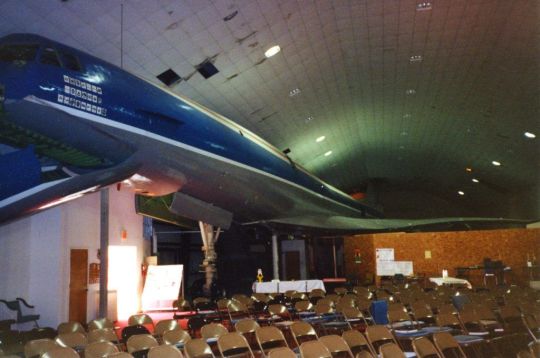
-The 2707 mockup some time in the 1980s. Sunday school classes were held under the port wing for nearly a decade. | Photo: Boeing
In 1990 the remnants of the mockup were sold to Stan Hiller, helicopter pioneer and owner of the Hiller Aviation museum. In 2013 the forward 90' section of the fuselage, now all that remained, were shipped to the Museum of Flight was part of a transfer between the two museums. What's left of the 2707-300 is now under restoration; the last remnants of a grand dream to move air travel forward at Mach 3.

-The remaining segment of the 2707, now 50 years after the program's termination. | Photo: Boeing
#aircraft#aviation#avgeek#airplanes#airplane#cold war#cold war history#coldwar#usaf#aviation history#sst#seattle supersonics#supersonic jet#supersonic transport#supersonic airliner#Boeing#Lockheed#the 60s#the 70s#the sixties#the seventies#faa#air travel#Concorde#boac#air france#Tupolev#tu-144#tu 144#concordeski
96 notes
·
View notes
Photo
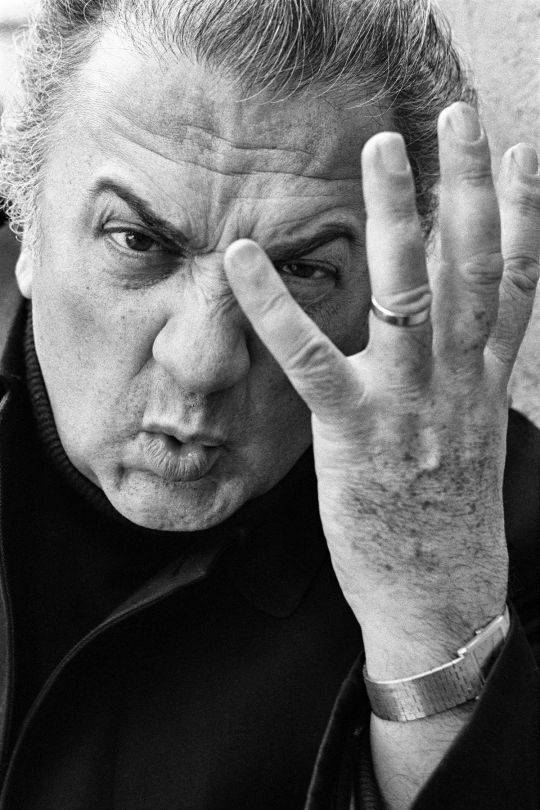
Federico Fellini, Cavaliere di Gran Croce OMRI, was born on January 20, 1920 in Rimini, then a small town on the Adriatic Sea. He was an Italian film director and screenwriter known for his distinctive style, which blends fantasy and baroque images with earthiness. He is recognized as one of the greatest and most influential filmmakers of all time. His films have ranked highly in critical polls such as that of Cahiers du cinéma and Sight & Sound, which lists his 1963 film 8 1⁄2 as the 10th-greatest film.
For La Dolce Vita Fellini won the Palme d'Or, was nominated for twelve Academy Awards, and won four in the category of Best Foreign Language Film, the most for any director in the history of the Academy. He received an honorary award for Lifetime Achievement at the 65th Academy Awards in Los Angeles. His other well-known films include La Strada (1954), Nights of Cabiria (1957), Juliet of the Spirits (1967), the "Toby Dammit" segment of Spirits of the Dead (1968), Fellini Satyricon (1969), Roma (1972), Amarcord (1973), and Fellini's Casanova (1976).
Personal and highly idiosyncratic visions of society, Fellini's films are a unique combination of memory, dreams, fantasy and desire. The adjectives "Fellinian" and "Felliniesque" are "synonymous with any kind of extravagant, fanciful, even baroque image in the cinema and in art in general". La Dolce Vita contributed the term paparazzi to the English language, derived from Paparazzo, the photographer friend of journalist Marcello Rubini (Marcello Mastroianni).
Contemporary filmmakers such as Tim Burton, Terry Gilliam, Emir Kusturica, and David Lynch have cited Fellini's influence on their work.
Polish director Wojciech Has, whose two best-received films, The Saragossa Manuscript (1965) and The Hour-Glass Sanatorium (1973), are examples of modernist fantasies, has been compared to Fellini for the sheer "luxuriance of his images".
I Vitelloni inspired European directors Juan Antonio Bardem, Marco Ferreri, and Lina Wertmüller and influenced Martin Scorsese's Mean Streets (1973), George Lucas's American Graffiti (1974), Joel Schumacher's St. Elmo's Fire (1985), and Barry Levinson's Diner (1982), among many others. When the American magazine Cinema asked Stanley Kubrick in 1963 to name his ten favorite films, he ranked I Vitelloni number one.
Nights of Cabiria was adapted as the Broadway musical Sweet Charity and the movie Sweet Charity (1969) by Bob Fosse starring Shirley MacLaine. City of Women was adapted for the Berlin stage by Frank Castorf in 1992.
8 1⁄2 inspired, among others, Mickey One (Arthur Penn, 1965), Alex in Wonderland (Paul Mazursky, 1970), Beware of a Holy Whore (Rainer Werner Fassbinder, 1971), Day for Night (François Truffaut, 1973), All That Jazz (Bob Fosse, 1979), Stardust Memories (Woody Allen, 1980), Sogni d'oro (Nanni Moretti, 1981), Parad Planet (Vadim Abdrashitov, 1984), La Pelicula del rey (Carlos Sorin, 1986), Living in Oblivion (Tom DiCillo, 1995), 8 1⁄2 Women (Peter Greenaway, 1999), Falling Down (Joel Schumacher, 1993), and the Broadway musical Nine (Maury Yeston and Arthur Kopit, 1982). Yo-Yo Boing! (1998), a Spanish novel by Puerto Rican writer Giannina Braschi, features a dream sequence with Fellini inspired by 8 1⁄2.
Fellini's work is referenced on the albums Fellini Days (2001) by Fish, Another Side of Bob Dylan (1964) by Bob Dylan with Motorpsycho Nitemare, Funplex (2008) by the B-52's with the song Juliet of the Spirits, and in the opening traffic jam of the music video Everybody Hurts by R.E.M. American singer Lana Del Rey has cited Fellini as an influence. His work influenced the American TV shows Northern Exposure and Third Rock from the Sun. Wes Anderson's short film Castello Cavalcanti (2013) is in many places a direct homage to Fellini.
Various film-related material and personal papers of Fellini are in the Wesleyan University Cinema Archives, to which scholars and media experts have full access. In October 2009, the Jeu de Paume in Paris opened an exhibit devoted to Fellini that included ephemera, television interviews, behind-the-scenes photographs, Book of Dreams (based on 30 years of the director's illustrated dreams and notes), along with excerpts from La dolce vita and 8 1⁄2.
In 2015, the Blue Devils Drum and Bugle Corps of Concord, California, performed "Felliniesque", a show themed around Fellini's work, with which they won a record 16th Drum Corps International World Class championship with a record score of 99.650. That same year, the weekly entertainment-trade magazine Variety announced that French director Sylvain Chomet was moving forward with The Thousand Miles, a project based on various Fellini works and first developed with Demian Gregory and Tommaso Rossellini, including his unpublished drawings and writings.
Filmography
As a director
1950 Variety Lights co-credited with Alberto Lattuada
1952 The White Sheik
1953 I vitelloni
1953 Love in the City Segment: Un'agenzia matrimoniale
1954 La strada
1955 Il bidone
1957 Nights of Cabiria
1960 La Dolce Vita
1962 Boccaccio '70 Segment: Le tentazioni del Dottor Antonio
1963 8 1⁄2
1965 Juliet of the Spirits
1968 Spirits of the Dead Segment: Toby Dammit
1969 Fellini: A Director's Notebook
1969 Fellini Satyricon
1970 I Clowns
1972 Roma
1973 Amarcord
1976 Fellini's Casanova
1978 Orchestra Rehearsal
1980 City of Women
1983 And the Ship Sails On
1986 Ginger and Fred
1987 Intervista
1990 The Voice of the Moon
As a screenwriter
1942 Knights of the Desert
1942 Before the Postman
1943 The Peddler and the Lady
1943 L'ultima carrozzella Co-scriptwriter
1945 Tutta la città canta Co-screenwriter and story author
1945 Rome, Open City Co-scriptwriter
1946 Paisà Co-scriptwriter
1947 Il delitto di Giovanni Episcopo Co-scriptwriter
1948 Senza pietà Co-scriptwriter
1948 Il miracolo Co-scriptwriter
1949 Il mulino del Po Co-scriptwriter
1950 Francesco, giullare di Dio Co-scriptwriter
1950 Il Cammino della speranza Co-scriptwriter
1951 La città si difende Co-scriptwriter
1951 Persiane chiuse Co-scriptwriter
1952 Il brigante di Tacca del Lupo Co-scriptwriter
1958 Fortunella Co-scriptwriter
1979 Lovers and Liars Fellini not credited
Television commercials
TV commercial for Campari Soda (1984)
TV commercial for Barilla pasta (1984)
Three TV commercials for Banca di Roma (1992)
Documentaries on Fellini
Ciao Federico (1969). Dir. Gideon Bachmann. (60')
Federico Fellini - un autoritratto ritrovato (2000). Dir. Paquito Del Bosco. (RAI TV, 68')
Fellini: I'm a Born Liar (2002). Dir. Damian Pettigrew. Feature documentary. (Arte, Eurimages, Scottish Screen, 102')
How Strange to Be Named Federico (2013). Dir. Ettore Scola.
Fellini died in Rome on 31 October 1993 at the age of 73 after a heart attack he suffered a few weeks earlier, a day after his 50th wedding anniversary. The memorial service, in Studio 5 at Cinecittà, was attended by an estimated 70,000 people. At Giulietta Masina's request, trumpeter Mauro Maur played Nino Rota's "Improvviso dell'Angelo" during the ceremony.
Five months later, on 23 March 1994, Masina died of lung cancer. Fellini, Masina and their son, Pierfederico, are buried in a bronze sepulchre sculpted by Arnaldo Pomodoro. Designed as a ship's prow, the tomb is at the main entrance to the Cemetery of Rimini. The Federico Fellini Airport in Rimini is named in his honour.
Daily inspiration. Discover more photos at http://justforbooks.tumblr.com
37 notes
·
View notes
Photo

DEBUTING AT TCAF 2020: The Unknown by Anna Sommer
$17 CND, Published by Conundrum Press, ISBN:978-1-77262-047-4 Graphic Novel 104 pages, 7×9.5 inches b/w, trade paper In light of TCAF 2020 cancelling, we are sharing comics and zines that were scheduled to debut at the festival.
A story of deceit, self-deception, and the search for happiness
When Helen finds a newborn abandoned in a changing room in her boutique, she decides to keep the baby nestled in a cardboard box and hidden from her husband. After Vicky is talked into sex work by her boarding school roommate, Wanda, all of Vicky’s secrets–including her affair with their history teacher and her pregnancy–are quickly uncovered.
As the two narratives converge, coincidences and secrets are revealed. Incisive, wicked and breezily unconcerned by taboos, Anna Sommer lets readers put together the pieces of her morally ambiguous fable.
The Unknown is the English language translation of Sommer’s L’Inconnu, a French language edition published by Les Cahiers Dessinés. In 2018, L’Inconnu was nominated for a prize at the prestigious Angoulême International Comics Festival.
======================
Anna Sommer was born in Staffelbach in 1968. She lives in Zurich and works as a freelance comics artist and illustrator for, among other publications, NZZ Folio, Die Zeit, Libération and Strapazin. In 2006 she was awarded a year-long grant to draw comics by the city of Zurich.
If your local indie shop is still open, please support them!
https://www.chapters.indigo.ca/en-ca/books/the-unknown/9781772620474-item.html?ikwid=the+unknown+somme&ikwsec=Home&ikwidx=0#algoliaQueryId=727e056a2e42ae173f9f7263a51b31a8
https://www.barnesandnoble.com/w/the-unknown-anna-sommer/1133785264?ean=9781772620474
Twitter: @ConundrumCanada
Instagram: @ConundrumPress
3 notes
·
View notes
Photo

Unknown , Hallucination - Gérard Dubois, 2014
French,b.1968-
Illustration
240 notes
·
View notes
Text

Gérard DuBois
Gif
14 notes
·
View notes
Text
The Lady Eve’s Reel Life and Silver Screen Modes are hosting the Vive la France! Blogathon. As my contribution I’ve chosen a film that takes us from French high society through the beautiful countryside and into Paris’ red light district. This is an adventure featuring fetching French felines from all walks of life in the final film green-lighted by Walt Disney and the company’s first feature-length animated film completed without him. I introduce you to The Aristocats directed by Wolfgang Reitherman based on a story by Tom McGowan and Tom Rowe.

Original reviews for The Aristocats in 1970 were great and the movie was a financial success, but since then it has lost some of that appeal for many. I dispute naysayers wholeheartedly with this entry as I deem The Aristocats one of the good ones, a leisurely 78 minutes of pure charm, good enough indeed to earn reissues in 1980 and 1987. The Aristocats offers a simple story that’s full of heart and touches upon such lofty ideas as the meaning of family, companionship, greed, betrayal, and the hero. The film also offers fantastic music and is characterized by an impressive list of voice actors led by Phil Harris and Eva Gabor, who are terrific. You’ll no doubt recognize many of the voices as they come straight out of many beloved classic TV shows.
Our story takes place in Paris in the early 1900s when we are invited into the home of the affluent Madame Adelaide Bonfamille (Hermione Baddeley.) Madame Adelaide lives with her cat family, Duchess (Gabor) and her three kittens, Toulouse, Marie, and Berlioz (Gary Dubin, Liz English, Dean Clark). The Madame’s butler Edgar (Roddy Maude-Roxby) also lives in the mansion. Straight off we know the Bonfamille home is a happy one with Adelaide enamored of Duchess and her brood. This is such, in fact, that Madame calls for her old, eccentric lawyer Georges Hautecourt (Charles Lane) to bequeath her vast fortune to Duchess and the kittens, leaving Edgar as the second place recipient should anything happen to the cat family.
As is always the case, someone has to spoil things and in the case of The Aristocats the butler does. You see, Edgar is not too happy that Madame Adelaide is leaving her fortune to cats and soon comes up with a plan to get rid of them. The plan is simple and sure to work – put sleeping pills in their food and take them far into the countryside. As you can imagine, Duchess and her kittens are ill-equipped for the wilderness having been pampered with unconditional love all of their lives. They are accustomed to canopied beds, the best food in Paris on the best china, and painting and music lessons. In fact, all three kittens exhibit quite a bit of talent. Marie takes after her mother with high society sensitivities and a lovely singing voice. Toulouse is a talented painter when he is not trying to imitate tough alley cats. And Berlioz is aces on the piano. All of this makes Edgar’s plans that much more sinister. And of course Madame Adelaide and their friends Roquefort the mouse (Sterling Holloway) and Frou-Frou the Horse (Nancy Kulp) are fraught with worry when they realize Duchess and the kittens are gone. None of them, especially Edgar, could ever have imagined that Duchess, Marie, Toulouse, and Berlioz were in for the adventure of a lifetime.
When Duchess and the kittens wake up after being dumped by Edgar they are initially startled by their surroundings but that doesn’t last long at all. From around the bend comes a ruggedly handsome, singing alley cat named Thomas O’Malley (Harris). Confirmed bachelor O’Malley can’t help but fall in love with Duchess and he soon becomes a father figure to the kittens after vowing to help them get back to the Bonfamille home in Paris.
Misadventures follow as Duchess’ family and O’Malley trek toward Paris. They meet up with two English geese, Amelia and Abigail Gabble, after O’Malley is rescued from a river. Their voices immediately recognizable, the Gabble sisters are portrayed by Monica Evans and Carole Shelley who played the Pigeon Sisters in The Odd Couple (1968) movie, TV series and the original Broadway production.
Meanwhile, Edgar is forced to return to the countryside to retrieve evidence he’d left behind, evidence now being utilized by stray hounds Napoleon and Lafayette (Blood and Bassett respectively). The two canine characters are portrayed by classic TV staples, Pat Buttram and George Lindsey. Their schtick, which centers on Napoleon’s insistence that he’s the leader while Lafayette has all the good ideas, is supremely entertaining.
Duchess, her kids, and O’Malley make it back to Paris, but not before running into a swingin’ group of musician cats led by Scat Cat (Scatman Crothers) who introduces the group to the wonders of jazz. This scene is one example of what makes The Aristocats such an entertaining endeavor – the music. Several of the songs are rip-roaring fun. Standouts are “Ev’rybody Wants to Be a Cat” words and music by Floyd Huddleston and Al Rinker, “Scales and Arpeggios” words and music by Richard M. Sherman and Robert B. Sherman and the title song “The Aristocats” also by the Sherman brothers, who wrote music for over 30 Disney pictures. The Aristocats was the last Disney animated feature the Shermans worked on as staff writers. Maurice Chevalier came out of retirement to sing the title song in the movie, which kicks things off with classic French flavor. This was Chevalier’s final work before his death in 1972.
More nods to France come courtesy of the various locations featured in The Aristocats. For instance, the film illustrates what an Alley Cat apartment looks like. The French countryside, which plays a prominent role, is as beautiful as you’d imagine and the farm where Napoleon and Lafayette hang out is reminiscent of scenes in many French-themed classic movies. Also, the legendary Eiffel Tower makes numerous background appearances as does Paris throughout. We are privileged to be allowed inside high society as well the Red Light district when all sorts of colorful characters reside. Viva La France! indeed.
Perhaps most lovely in the journey of our characters is the love that surfaces between Thomas O’Malley and Duchess. He falls head over heels, but she’s conflicted. Not about her love for him, but because she worries for Madame Adelaide who has always said that Duchess and her babies are her greatest gift. Duchess’ loyalty for Adelaide is sweet, heartfelt and touches me deeply as I think about the cat that lives in my own home and wonder if she’d run at the first sign of true love. It’s a warm and fuzzy feeling when Duchess’ loyalty to Adelaide wins and she decides to go home again. Unfortunately, there to meet her with evil intentions is Edgar who immediately traps Duchess and the kittens in a sack to ship them to Timbuktu. Before that happens, however, the feline family gets word to Roquefort the mouse to find O’Malley who is headed back to the countryside. O’Malley in turn gathers Scat Cat and his troupe to save the day. O’Malley joins Duchess, her family, and Madame Adelaide in the mansion where love and acceptance abound.
The ending of The Aristocats is a touching reminder that sometimes we don’t have to choose between loyalty and love. Sometimes the two go hand-in-hand for lucky cats and the people who love them. That’s true from New York, New York to Paris, France and everywhere in between.
◊
Be sure to visit The Lady Eve’s Reel Life and Silver Screen Modes as they host the Viva La France! Blogathon on August 25 and 26. Ce Sera amusant pour tous en style!

Disney’s THE ARISTOCATS (1970) The Lady Eve’s Reel Life and Silver Screen Modes are hosting the Vive la France! Blogathon. As my contribution I’ve chosen a film that takes us from French high society through the beautiful countryside and into Paris’ red light district.
#Disney&039;s The Aristocats#Eva Gabor#Maureice Chevalier#Phil Harris#The Aristocats#Wolfgang Reitherman
5 notes
·
View notes
Text
Birthdays 8.14
Beer Birthdays
Eugene L. Husting (1848)
Brandon Hernández (1976)
Five Favorite Birthdays
Emmanuelle Beart; French actor (1965)
Halle Berry; actor (1968)
Mila Kunis; Ukrainian-American actor (1983)
Gary Larson; cartoonist (1950)
Steve Martin; comedian, actor, writer, banjo player (1945)
Famous Birthdays
Russell Baker; essayist (1925)
Emmanuelle Béart; French actress (1963)
Catherine Bell; actor (1968)
Herman Branson; African-American physicist, chemist (1914)
Sarah Brightman; English singer-songwriter (1960)
John Brodie; San Francisco 49ers QB (1935)
Lodewijk Bruckman; Dutch painter (1903)
Sharon Bryant; R&B singer (1956)
Kevin Cadogan; rock singer-songwriter, guitarist (1970)
Méric Casaubon; Swiss-English author (1599)
Yannoulis Chalepas; Greek sculptor (1851)
Darrell "Dash" Crofts; singer-songwriter and musician (1940)
David Crosby; rock singer (1941)
Charles Jean de la Vallée-Poussin; Belgian mathematician (1866)
Mstislav Dobuzhinsky; Russian-Lithuanian-American artist (1875)
Slim Dunlap; singer-songwriter and guitarist (1951)
Tracy Caldwell Dyson; chemist and astronaut (!969)
Richard R. Ernst; Swiss chemist (1933)
Erica Flapan; mathematician (1956)
Francis Ford; actor and director (1881)
John Galsworthy; English writer (1867)
Alice Ghostley; actor (1926)
Larry Graham; soul/funk bass player and singer-songwriter (1946)
Buddy Greco; singer, pianist (1926)
Marcia Gay Harden; actor (1959)
Jackée Harry; actress (1956)
Robert Hayman; English-Canadian poet (1575)
Lee Hoffman; author (1932)
Leopold Hofmann; Austrian composer (1738)
Doc Holliday; dentist, wild west gambler (1851)
James Horner; composer (1953)
Ernest Everett Just; African-American biologist (1883)
Jan Koetsier; Dutch composer (1911)
Margaret Lindsay Huggins; Anglo-Irish astronomer (1848)
William Hutchinson; founder of Rhode Island (1586)
Magic Johnson; Los Angeles Lakers (1959)
Stanley A. McChrystal; American general (1954)
John McCutcheon; folksinger (1952)
Paddy McGuinness; English comedian (1973)
Lionel Morton; English singer-songwriter, guitarist (1942)
Bruce Nash; film director (1947)
Frank Oppenheimer; particle physicist (1912)
Hans Christian Ørsted; Danish physicist and chemist (1777)
Susan Saint James; actor (1946)
Paolo Sarpi; Italian writer (1552)
Ben Sidran; jazz and rock keyboardist (1943)
Stuff Smith; violinist (1909)
Danielle Steel; writer (1947)
Jiro Taniguchi; Japanese author and illustrator (1947)
Bruno Tesch; German chemist (1890)
Ernest Thayer; "Casey at the Bat" writer (1863)
Bruce Thomas; English bass playe (1948)
Pieter Coecke van Aelst; Flemish painter (1502)
Carle Vernet; French painter and lithographer (1758)
Claude Joseph Vernet; French painter (1714)
Earl Weaver; Baltimore Orioles manager (1930)
Wim Wenders; German film director (1945)
Lina Wertmüller; Italian film director (1926)
2 notes
·
View notes
Text
All You Want To Know About Getting Music On The Internet
As hip-hop continues to evolve as a genre, categorizing sub genres by sound or location is turning into a increasingly more troublesome activity. Rock was not with out its triumphs in 2016, nevertheless. Bob Dylan received the Nobel Prize in Literature There was something ironic in Dylan's triumph, in that Dylan's influence shouldn't be as strong as it as soon as was. Common music could have outdated literature as a cultural affect long ago, however different genres have supplanted rock, folk, and blues. Dylan's Nobel Prize win additionally felt like a belated shot in a tradition struggle that ended way back—anyone who does not suppose Dylan's music needs to be taken critically is rightfully dismissed as a crank. In a 12 months by which pop music—from Robyn to Ariana Grande—was making a powerful assertion, singer Héloïse Letissier, who performs as Christine and the Queens, arrived from France to continue the dialog about gender and id on Chris. On Would not Matter"—over daring poppy '80s drums and sparkling synth—Héloïse bravely addresses the pressures of the masculine gaze, suicidal thoughts, and the character of relationships and faith. It's a heavy and vital dialog to be having—particularly in a song full of as a lot buoyant French enjoyable as this one. On Facet One our Kate strikes a deal with God, throws her sneakers in a lake and poses as somewhat boy driving a rain machine. Turn over, and she or he's drowning, exorcising demons and dancing an Irish jig. All this to a soundscape that employs the shiniest synthesised studio toys the Eighties had to supply within the service of one women's unique but utterly English musical genius. Pay attention again to the delirious cacophany of 'Working Up That Hill', and it appears like God struck that deal.

A examine out of Finland additionally looked on the emotional properties of music and its impression on memory formation, but with a twist. It compared how music impacted the reminiscences of those with musical backgrounds versus those without Those with a musical background did higher on the memory tasks if neutral music was taking part in, reasonably than pleasurable music. The opposite was true for those with out musical backgrounds. The conclusion drawn here is that pleasurable music was too distracting to individuals with musical backgrounds. In essence, their brains had been too busy analyzing the music they enjoyed to form new reminiscences. Whereas these and not using a musical background had been reacting to the positive feelings inspired by the pleasurable music, which helped them enhance their quick-time period reminiscence. Now, you recognize, when you think about that jazz is great American music, it has been four or five a long time, I believe 1963, since jazz received record of the yr for Grammy presentation. I imply, that's astonishing to me. So perhaps there's a beacon of light now that has been shined upon us to perhaps make folks look a bit of bit more deeply into what artwork is de facto about. What it means. And I'm so pleased that Herbie won this record as a result of it was the only jazz report nominated for record of the year. Simply earlier than his tragic dying in a airplane crash in Madison, Wis., in late 1967, Otis Redding had accomplished recording (Sittin' on) The Dock of the Bay", perhaps his biggest track and the first document to ever develop into a posthumous No. 1 hit. Was Otis Redding pondering of Vietnam? We'll by no means know for sure, however he'd agreed to journey to Vietnam to entertain the troops shortly before his passing. Frank Free, an data specialist at USARV Headquarters at Long Binh in 1968-69, admits that he gravitated to music that expressed emotions of craving and loneliness, and that Redding's portrait of the lonely wanderer resting by the ocean watching the solar go down in (Sittin' on) The Dock of the Bay" perfectly captured that feeling. For many people, our taste in music is an integral a part of our identification - so much in order that, to a certain extent, what we hearken to is who we are. The songs of our youth, heard a thousand times, fill our headspace with stray lyrics and infectious grooves, creating a filter for the way we see, hear, and perceive the world from then on out. And whereas some have a much less aware, more natural approach, others actively draw boundaries between the music they settle for and the music they deny - and by extension, the people associated with these musical cultures, as effectively.
Earlier than the pc age" musicians caught with a given music genre. If you have been asked to group the different musicians in particular categories depending on their musical expertise, it was very straightforward to do. That is now not the case. Genres in at the moment's music are blurred as the modern musicians" match totally different genres. Currently, it's not uncommon to discover a musician singing hip-hop and but playing within the R&B type. Some musicians have even gained awards in music categories they are not famous for. For example, Nelly, who is understood for R&B, has won a rustic music award. Due to the limited confinement of the completely different music genres, the music world has become confused and it's virtually unimaginable to tell the specific style that a given musician engages in.
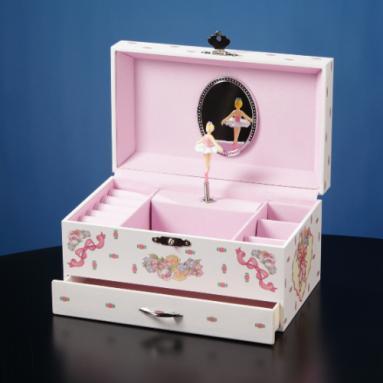
Artistic Commons is a system that lets you legally use some rights reserved" music, movies, photographs, and different content material — all at no cost. CC gives free copyright licenses that anyone can use to mark their inventive work with the freedoms they need it to hold. As an illustration, a musician might use a Inventive Commons license to allow individuals to legally share her songs online, make copies for mates, or even use them in videos or make remixes. For extra data, go to our Be taught More page.

Romantic music (c. 1810 to 1900) from the 19th century had many components in widespread with the Romantic types in literature and portray of the era. Romanticism was an inventive, literary, and mental movement was characterised by its emphasis on emotion and individualism in addition to glorification of all of the previous and nature. Romantic music expanded past the inflexible kinds and forms of the Classical period into more passionate, dramatic expressive items and songs. Romantic composers similar to Wagner and Brahms tried to increase emotional expression and www.audio-transcoder.com power of their music to explain deeper truths or human emotions. With symphonic tone poems , composers tried to tell tales and evoke images or landscapes utilizing instrumental music. Some composers promoted nationalistic pride with patriotic orchestral music inspired by folk music The emotional and expressive qualities of music got here to take priority over custom.
1 note
·
View note
Link
0 notes
Text
Supply Chain Issues
New Post has been published on https://supplychainmanagementcertificate.com/2021/08/24/supply-chain-issues-2/
Supply Chain Issues

Contents
1 McDonald’s runs out of milkshakes amid ‘supply chain issues’
2 Shortage of lorry drivers reportedly to blame for issue affecting 1,250 outlets in England, Scotland and Wales
3 The McDonald’s Story
3.1 The McDonald Brothers
3.2 Ray Kroc
3.3 Going Global
4 Visit McDonald’s Restaurants
4.1 The Red and White
4.2 Mansard Roof
4.3 Today
5 Timeline
5.1 1940
5.2 1948
5.3 1949
5.4 1954
5.5 1955
5.6 1956
5.7 1961
5.8 1965
5.9 1968
5.10 1973
5.11 1974
5.12 1975
5.13 1983
5.14 1984
5.15 1990
5.16 1993
5.17 1995
5.18 2002
5.19 2003
5.20 2015
5.21 2017
5.22 2020
McDonald’s runs out of milkshakes amid ‘supply chain issues’
Shortage of lorry drivers reportedly to blame for issue affecting 1,250 outlets in England, Scotland and Wales
Caroline Davies
Milkshakes are off the menu at McDonald’s in England, Scotland and Wales, leaving customers definitely not “lovin’ it” after supply chain issues.
The fast-food chain has also been left without some bottled drinks across its 1,250 outlets in Great Britain this week.
It is understood to be caused by a shortage of lorry drivers owing to post-Brexit EU immigration rules, Covid-19 restrictions and self-isolation guidance.
The burger chain is said to be working hard to restore the items to the menu as soon as possible.
Last week, Nando’s was forced to close about 50 restaurants because of chicken shortages. It blamed staffing shortages at suppliers and a reduced number of lorry drivers. KFC also said recently that supply chain issues meant it was unable to stock some menu items.
A McDonald’s spokesman said the group is “working hard to return these items to the menu”. He said: “Like most retailers, we are currently experiencing some supply chain issues, impacting the availability of a small number of products.
“Bottled drinks and milkshakes are temporarily unavailable in restaurants across England, Scotland and Wales.
“We apologise for any inconvenience, and thank our customers for their continued patience.”
The burger chain is the latest firm in several sectors battling supply chain issues. Gaps on supermarket shelves are likely to continue for several months unless the government does more to tackle the labour crisis hitting haulage firms, suppliers have warned. Some manufacturers have reported sharp increased in the prices of raw materials.
The shortage of qualified HGV drivers, worsened by Brexit and Covid, has left wholesalers unable to get goods to shops.
Logistics and hauliers’ organisations said August would be a pinch point in the shortage as workers take summer breaks, while firms offering bonuses and sign-on fees to recruit drivers were not helping matters.
Business groups representing the retail and transport sectors have been calling for the government to review plans not to grant temporary work visas to drivers from the EU.
Lobby groups for the sectors affected have written to the business secretary, Kwasi Kwarteng, outlining the lorry driver shortage and the knock-on effect to supply chains. They want a review of plans not to grant temporary work visas to drivers from the EU.
The McDonald’s Story
The McDonald Brothers
Dick and Mac McDonald moved to California to seek opportunities they felt unavailable in New England. Failing in the movie business, they subsequently proved successful in operating drive-in restaurants. In 1948 they took a risk by streamlining their operations and introducing their Speedee Service System featuring 15 cent hamburgers. The restaurant’s success led the brothers to begin franchising their concept—nine becoming operating restaurants. At the San Bernadino location, Dick and Mac McDonald perfected their Speedee Service System featuring a limited menu including fifteen cent hamburgers, shakes and fries. The brothers sold 14 franchises of which 10 became operating restaurants not including their original location in San Bernardino.
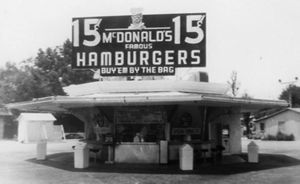
McDonald brothers San Bernardino McDonald’s restaurant 1948-1955.

McDonald brothers franchised brochure c. 1952.
Ray Kroc
A native Chicagoan, Ray Kroc left high school after his sophomore year to join the World War One Red Cross Ambulance Corps. The war ended before his unit was sent overseas with Ray returning home to earn a living as a musician and later selling paper cups. In 1939, he became the exclusive distributor of the Multimixer (a milkshake mixing machine). He visited the McDonald brothers in 1954 which led to him becoming their franchise agent. In 1955, Kroc opened the first McDonald’s east of the Mississippi river.
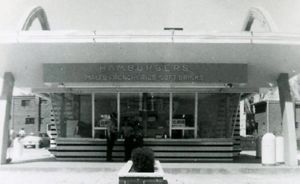
Ray Kroc’s first McDonald’s restaurant in Des Plaines, Illinois just prior to opening on April 15, 1955.
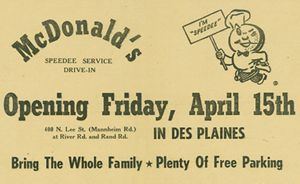
Newspaper advertisement announcing the opening of Ray Kroc’s first McDonald’s.
[Kroc] opened up the first restaurant for McDonald’s System, Inc., a predecessor of McDonald’s Corp. in Des Plaines, Illinois in April, 1955. McDonald’s acquired the rights to the brother’s company in 1961 for $2.7 million.
Going Global
Ray Kroc’s vision was that there would be 1,000 McDonald’s restaurants solely in the United States. Yet, McDonald’s continued to grow and expand into international markets beginning in 1967 opening in Canada and Puerto Rico. Today, the company has over 36,000 restaurants in over 100 nations. The most recent opening in Kazakhstan in 2016.
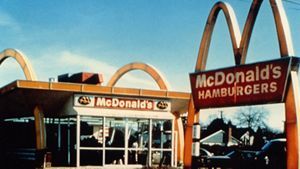
McDonald’s expanded into international markets with the opening in Canada of its restaurant in Richmond, British Columbia in June, 1967.
Back to Top
Visit McDonald’s Restaurants
Dick and Mac McDonald moved to California to seek opportunities they felt unavailable in New England. Failing in the movie business, they subsequently proved successful in operating drive-in restaurants. In 1948 they took a risk by streamlining their operations and introducing their Speedee Service System featuring 15 cent hamburgers. The restaurant’s success led the brothers to begin franchising their concept—nine becoming operating restaurants.
The Red and White
The McDonald brothers insisted that their architect design an attention catching building that would highlight their Speedee Service System. Architect Stanley Meson design of the “Red and White” did not disappoint. Feeling that the roof line was a bit too flat Dick McDonald added arches to the building. This building design was first used in 1953 until it was replaced by the Mansard Roof design in the late 1960s.
A sign maker incorporated yellow neon into them creating the “Golden Arches”. The oldest McDonald’s Red and White (opened in 1953) still operating today is in Downey, California.

Early blueprints for signature McDonald’s Red and White restaurant with Speedee road sign.
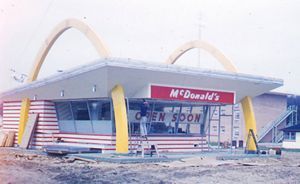
McDonald’s of DeKalb, Illinois shortly before its opening in May, 1960.
Mansard Roof
McDonald’s introduced the new Mansard Roof Design in 1969 in Matteson, Illinois. Initially, many franchisees remodeled their existing Red and White buildings to reflect the new design. McDonaldland Parks (Play Places) and the Drive-Thru were added to the restaurant during the 1970s. The Mansard’s exterior underwent several changes during the intervening years.
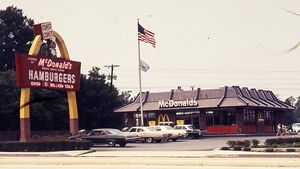
An adapted Mansard Roof of remodeled Red & White building 1970 features a traditional Speedee road sign.

McDonald’s in Fresno, California illustrating the transition from the Red and White—to its remodel—with the eventual opening of the Mansard design in the 1973.
Today
McDonald’s restaurants feature designs that incorporate existing architecture and other unique features. The architecture of the McDonald’s continues to evolve to meet our customer’s expectations.
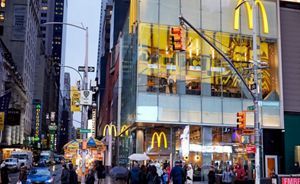
McDonald’s in Times Square
Back to Top

First net zero-designed restaurant at Disney
Timeline
1940
Dick and Mac McDonald open McDonald’s Bar-B-Q restaurant on Fourteenth and E streets in San Bernardino, California. It is a typical drive-in featuring a large menu and car hop service.
1948
The McDonald brothers shut down their restaurant for three months for alterations. In December it reopens as a self-service drive-in restaurant. The menu is reduced to nine items: hamburger, cheeseburger, soft drinks, milk, coffee, potato chips and a slice of pie. The staple of the menu is the 15 cent hamburger.
1949
French Fries replace potato chips and debut Triple Thick Milkshakes on the McDonald’s menu.
1954
Multimixer salesman Ray Kroc visits McDonald’s in San Bernardino intending to sell the brothers more Multimixers. The 52 year old Kroc is fascinated by the operation. He learns from the brothers that they are looking for a nationwide franchising agent. He has an epiphany and is determined that his future would be in hamburgers.
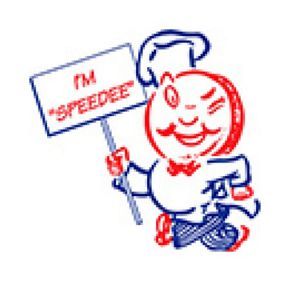
1955
Kroc opens his first McDonald’s in Des Plaines, Illinois on April 15. The attention getting red and white tiled building with the Golden Arches was designed by architect Stanley Meston in 1953. First day sales are $366.12.
1956
Fred Turner, future McDonald’s Chairman is hired to work as a counter man for the Des Plaines McDonald’s. He would soon become the head of McDonald’s Operations defining the quality, service and cleanliness that continue to this day.

1961
Hamburger University opens in the basement of the Elk Grove Village, Illinois, McDonald’s restaurant. Graduates receive Bachelor of Hamburgerology degrees.
1965
The Filet-O-Fish sandwich was the first item added to the national menu. Created by Lou Groen, McDonald’s Cincinnati franchisee to help build volume in the predominately Roman Catholic community in which his store was located.

1968
The Big Mac, developed by Owner/Operator Jim Delligatti of Pittsburgh, is added to the national menu.
1973
The Quarter Pounder and the Quarter Pounder with Cheese are added to the menu.
1974
The first Ronald McDonald House opens in Philadelphia, Pennsylvania. In 1973, Fred Hill, a football player with the Philadelphia Eagles, had the need for such a facility at Children’s Hospital in Philadelphia, where his child was being treated for leukemia. Hill’s dilemma led to the first Ronald McDonald House.
1975
The Egg McMuffin, created by Owner/Operator Herb Peterson of Santa Barbara, California is added to the national menu.

1983
Chicken McNuggets are introduced into all domestic U.S. restaurants.
1984
Ray Kroc, Founder and Senior Chairman of the Board of McDonald’s Corporation, dies on January 14.
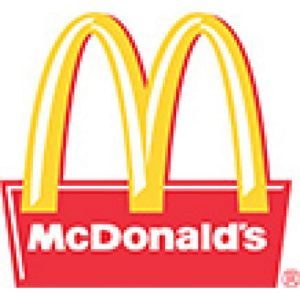
1990
On January 31, the first McDonald’s restaurant in Moscow opens. Located in Pushkin Square, more than 30,000 customers were served on opening day.
1993
The world’s first McCafé opens in Melbourne, Victoria Australia.
1995
McFlurry Desserts, invented by Ron McLellan, O/O Canada are added to McDonald’s Canada menu.

2002
McDonald’s published its first ever Social Responsibility Report on April 15, 2002.
2003
McDonald’s first global ad campaign, “i’m lovin’ it” is launched in Munich, Germany on September 2.
2015
McDonald’s USA launched All Day Breakfast.

2017
Global McDelivery Day is celebrated on July 26 to support the global launch of McDelivery with UberEATS.
2020
McDonald’s opens its first net zero-designed restaurant at Walt Disney World Resort, which creates enough renewable energy on-site to cover 100% of its energy needs on a net annual basis.
0 notes
Text
Some of My Updated Art History Tags

Primavera, 1482, by Sandro Botticelli (c. 1445-1510).
ARTISTS l MOVEMENTS l TECHNIQUES l TIMELINE
Time periods:
Here is everything - artists, techniques, movements, and artwork - together, organised by time periods:
Ancient Art
Medieval Art (ca. 400- 500)
Renaissance Art (ca. 1300-1600);
The Renaissance: The Early Renaissance (c.1400s-)
13th Century; 1200s�� l 14th Century; 1300s
15th Century; 1400s l 16th Century; 1500s
17th Century; 1600s l 18th Century; 1700s
19th Century; 1800s l 20th Century; 1900s
Contemporary Art
Forms of media:
Sculpture & Painting l Collage l Performance Art Design l Fashion l Embroidery Poetry l Quotes l Videos
Artists:
Female Artists l Famous Artists
A list of artists in alphabetical order (of last name):
A
Anguissola, Lucia (c. 1536-c. 1565); female Italian Renaissance artist Anguissola, Sofonisba (c. 1535-1625); female Italian Renaissance artist Anquetin, Louis (1861-1924); cloisonnism
B
Bailey, Amadea; female contemporary expressionist artist Barboza, Ana Teresa (1980- ); contemporary art; embroidery Beksiński, Zdzisław (1929-2005); dark surrealism Booth, Anastasia; contemporary sculpture/installation/photography artist
C
Cabanel, Alexandre (1823-1889); french academic artist Carlson, Larry; digital contemporary artist
D
Darger, Henry (1892-1973); an outsider artist
E
Ekster, Aleksandra (1882-1949); abstract designer
F
Fontana, Lavinia (1552-1614); female Italian Renaissance painter
G
Galizia, Fede (c. 1578-c. 1630); female Italian Renaissance painter Gogh, Vincent van (1853-1890); dutch artist; post-impressionist (also, The Death of Vincent van Gogh) Goodsir, Agnes (1864-1939); australian-born artist known in France
H
Hemessen, Catharina van (1528-c. 1565); female Flemish Renaissance artist
K
Kahlo, Frida (1907-1954); modern female artist; surrealism Kandinsky, Wassily (1866–1944); russian abstract painter Klimt, Gustav (1862-1918); austrian artist Kondakov, Alexey; contemporary collage artist
L
Lempicka, Tamara de (1898-1980); female art deco painter Lewis, Edmonia (c. 1844-1907); African-American/Native American female sculptor Longhi, Barbara (1552-1638); female Italian Renaissance artist Lundeberg, Helen (1908–1999); surrealist
M
Makart, Hans (1840-1884); was Austria’s most sought-after artist during his time Monet, Claude (1820-1926); impressionist Mucha, Alphonse (1860-1939); czech illustrator Moser, Mary (1744-1819); English academic artist known for her flower works
N
Nelli, Plautilla (1524-1588); self-taught artist nun during the Renaissance in Florence
R
Rockwell, Norman (1894-1978); American illustrator Rodin, Auguste (1840-1917); famous French sculptor
S
Sandys, Emma (1843-1877); female pre-raphaelite artist Savage, Augusta (1892–1962); famous female artist during the Harlem Renaissance Serov, Valentin (1865-1911); impressionist Shōen, Uemura (1875-1949); female Japanese artist Siddal, Elizabeth (1829-1862); female Pre-Raphaelite muse, artist, and poet Sterrett, Virginia Frances (1900-1931); american illustrator Stokes, Marianne (1855-1927); victorian female artist
T
Taeuber-Arp, Sophie (1889-1943); known for abstract textile art Tiffany, Louis Comfort (1848-1933); stained glass artisan Tissot, James (1836–1902); french artist Turner, J. M. W. (c. 1775-1851); romanticist landscape artist
U
Utamaro, Kitagawa (c. 1753-1806); japanese ukiyo-e woodblock artist
W
Wolfli, Adolf (1864-1930);outsider artist
Y
Yuliang, Pan (1899-1977); first woman to paint in western style in China
Z
Zorach, Marguerite (1887-1968); fauvist painter
I also have tags sorted by nationality of art/artist (although it needs some work). If you are interested in exploring it, it’s on this page.
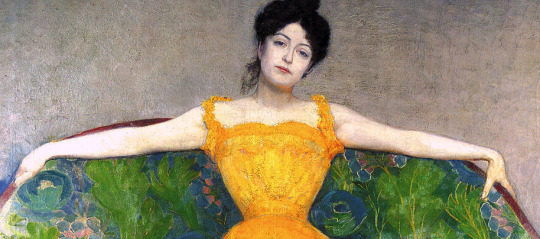
Woman in a Yellow Dress, 1907, by Max Kurzweil (1867-1916).
Other Stuff You Might Enjoy:
Recommended Art Books
Information Tag
Exhibition History:
Hitler and Degenerate Art
Artist History:
William Morris’ Part in Arsenic Houses
The Death of Vincent van Gogh
The Last Painting of Frida Kahlo
Painting History & Painting Analysis:
The Sick Child, by Edvard Munch
The Lady with the Veil, by Alexander Roslin (One of my favourite paintings)
Analysis of the painting Salomé, 1909, by Paul Antoine de la Boulaye
The History Behind La Mort de Barbara Radziwiłł, 1841, by Józef Simmler
In Bed, The Kiss, 1892, by Henri Toulouse-Lautrec (1864-1901)
The History Behind Gustav Klimt’s ‘The Woman in Gold’
Sculpture History & Sculpture Analysis:
Venus of the Beautiful Buttocks
Sculpture of Pietà
Who’s in Antonio Canova's The Three Graces?
My followers’ art; if you’re an artist, or just enjoy drawing/painting/etc, I’d love to see your art!
#list#art#art history#art history blog#painting#sculpture#artwork#fine art#contemporary art#renaissance#tags#artists#artist#paintings#famous art
1K notes
·
View notes